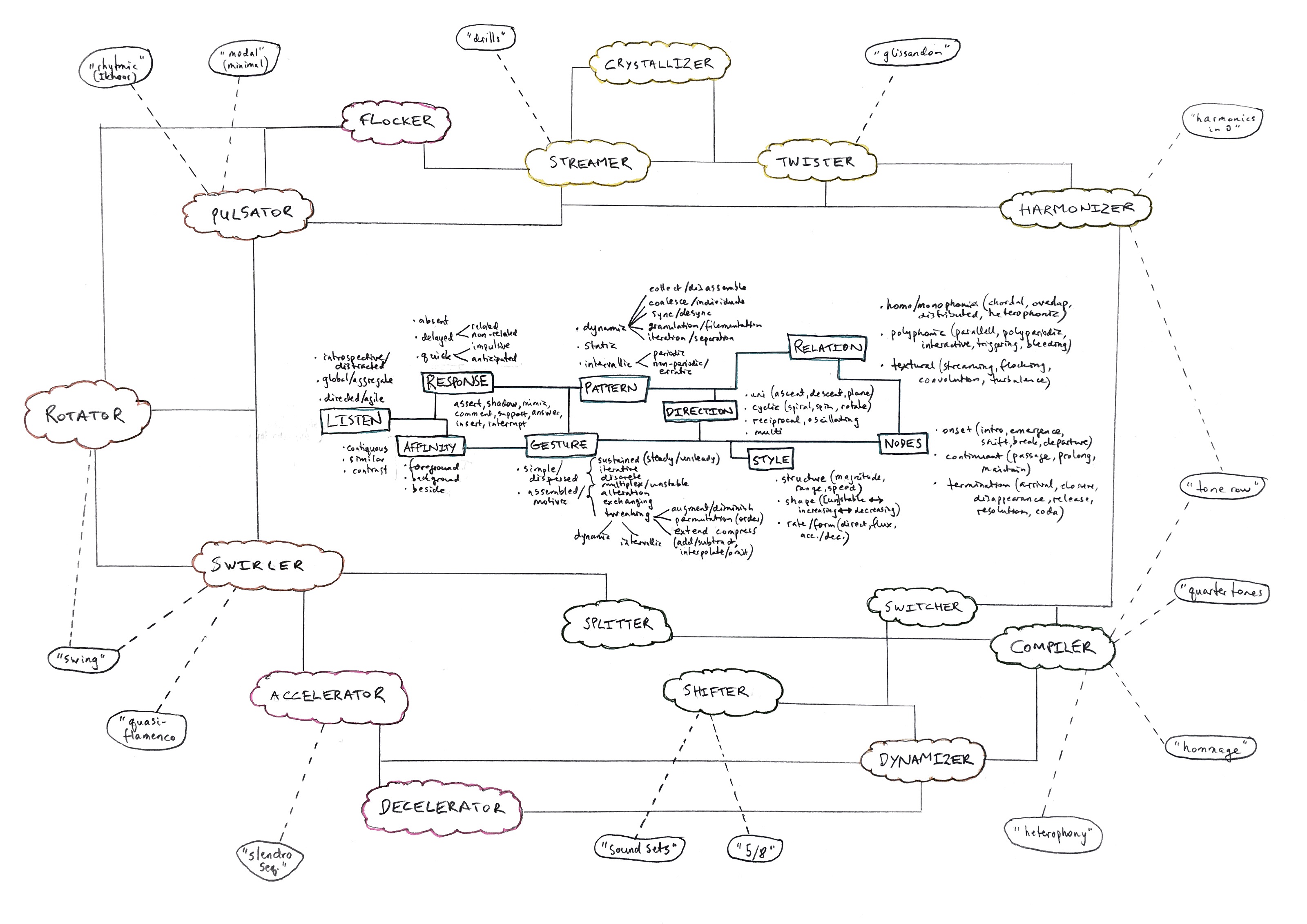Lab Days #10 – Black Box (Royal College of Music, Stockholm)
For this session Klas had synthesized the theoretical work we did in March, adding valuable ideas from Trevor Wishart’s On Sonic Art, and inspired by a more thorough use of Deleuze and Guattari’s approach to concepts (What is Philosophy?) as well as philosophical works on duration and heterogeneity related to complexity theory (e.g., the new materialism of Manuel DeLanda). The result was a new map (see further below) that brought together concepts and methods in one working material. We are now reserving the term Module for when we wish to introduce specific (more or less pre-composed) materials, and are distinguishing between other concept-methods in terms of Modulators, Resonators and Attractors.
04/21/18 “18_Dynamizer”
04/21/18 “12 Free mixture (pulsator & rotator)”
04/21/18 “28 Free mixture (compiler, pulsator + direction resonator)”
04/21/18 “08 Free mixture (harmonizer, compiler, twister)”
Reflections on the new score
The new score we are working with now, which employs conceptual drivers with the monikers attractors, modulators and resonators, transforms the act of improvising based on a score to one of playing from a shared set of conceptual frameworks, musical materials and experiences built from previous scores. It is fitting that the elements of this new step in the process, which functions more like a structural map of these shared processes in the group than a score for me, also binds ideas of order and chaos together in ways that manifest in playing.
The process in the overall project has been the breaking down of modular materials and fairly specific compositions drawn from scores, through which both the research group and the musicians who joined us in concerts and workshops rediscovered and reordered that material through play/ing. This latest score is different. It is re-ordered not only from the compositional processes Klas has employed, but equally – or perhaps even more – from the improvisational work in the project. Thus I find it fitting that its elements are named as actions rather than objects. I found that the way we played was more action-oriented in some sense, as we combined these processes, moving fluidly in and out of them towards and away from spontaneous playing. The balance in the music I both remember hearing and have revisited in recordings from these lab days between entirely new music and that which comes very recognizably from the ever evolving materials of the original modules is delicate and very focused. It is a balance which feeds intensity, in a way that points to the project’s reflection on order, chaos and power dynamics.
It was also interesting to experience the difference between the three types of processes, and how they acted upon one another. For example, when playing a resonator that specified methods like “sync/desync” or “collect/disassemble” with a modulator that contained interlocking pulses (Rotator combined with Pattern), complexities unfolded focused attention to detailed layering that would not have been likely using either process alone, nor even in the freely improvised music that has come to tacitly contain so much of the group’s work.
In employing these new and newly articulated processes, I continued to find myself inspired by how detailed and complex the tacit understanding of original modular compositions is in the group, and by how this manifests in the music we play. As has been the case throughout the project, when the group shifts to “free” playing, laying aside the intentional use of scores of materials, those ideas remain and inform the music through collective, shared experience in ways tangible, I think, to all of us. In this respect, the project continues to be a microcosm of the kinds of communities that form around various improvised music players or groups in contexts outside out research group. The way the new score/map blends theoretical materials (like Flocker or Dynamizer) with those explicitly abstracted from earlier modules (like Harmonizer or Twister) emulates the way one thinks when improvising without prior articulated structures or materials. The synchronicities and communal experiences that issue from improvised music come forth from an ever shifting set of leaps and bounds between very specific material or technical ideas and larger scale theoretical, compositional and ex-musical imaginings and ideas, exactly as this new score emulates.
-Katt Hernandez
